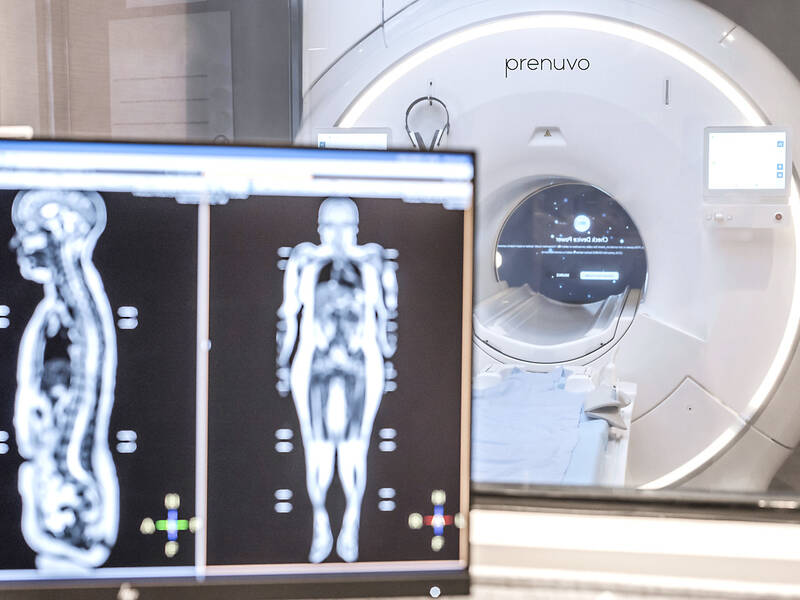Whole-body MRI scans have been around for more than a decade but it is only lately that they have started taking over social media feeds.
In a promotional post on Instagram last year, Kim Kardashian wrote about her experience of being scanned by what she called a “life saving machine.”
“It has really saved some of my friends lives and I just wanted to share,” she posted.

Photo: AP
Paris Hilton shared a similar experience of having a full-body scan to “proactively” rule out breast cancer.
“I encourage every single one of you to go get a scan,” she said.
Social media influencers and entrepreneurs promote the full-body MRIs as “super scans” that can detect early cancers and alert people to “silent killers.” They’re sold by tech and radiology companies as a risk-free way of getting a “complete health check” in an attempt to prolong your life.

Photo: AFP
But while the scans can be useful for people at high risk of certain genetic conditions or cancers, is there any evidence they can help people with an average or low risk of disease?
WHAT IS A FULL-BODY MRI?
The scan involves lying still on a long, narrow table which slides into a cylindrical machine. Powerful magnets, radio waves and computer imaging are used to create highly detailed images of the organs, joints and tissues.
Advertisements for the scans promote their ability to detect early signs of illness and present them as risk-free, aside from the discomfort that might come from lying on your back in an enclosed space for about an hour.
There are now private clinics offering the scans for upwards of US$800 to anyone who wants one — even if they have no symptoms or a referral from a doctor. The implication is almost anyone is a good candidate.
With most people affected by or aware of someone with cancer or heart disease, it may seem like a small price to pay for apparent peace of mind.
But according to those who endorse the scans, including celebrities, benefits abound, including the ability to detect things like cancer and aneurysms in their earliest stages, before symptoms arise.
WHAT DOES THE EVIDENCE SAY?
The University of Sydney public health researcher Brooke Nickel says full-body MRI scans can in fact have unintended negative consequences.
Expanding disease definitions and lowering diagnostic thresholds mean more people previously considered healthy or at low risk may now be classified as having a health condition or an indicator of disease, such as a shadow on an organ. This is known as overdiagnosis.
“The main concern with full-body MRI scans is that they have the ability to detect inconsequential disease leading to unnecessary diagnosis and treatments,” Nickel says.
“This can lead to individual harm and also impact the health system.”
Harms include the fear and anxiety that comes from being told something has been detected on a scan; the feeling that any abnormality should be treated and eliminated “just in case;” and the risk that comes with additional treatments to address whatever the scan may find. These treatments might be unnecessary, costly and come with side-effects.
Nickel says companies that manufacture medical devices and treatments can benefit from people’s fear of becoming unwell and their desire to be informed, by coming up with new health screening tools and detection tests, such as a full-body MRI.
“The premise that knowledge and information is power, while it used to make individuals feel more empowered about their health, is concerning when used by commercial entities or those with vested interest in relation to health interventions like tests, treatments and technology that are non-evidence based,” she says.
The tests can also be overly reassuring. A heavy smoker or regular drinker may feel there is no need to address those habits if a full-body scans reveals no abnormality. And full-body MRIs are not the best tool for detecting many of the diseases or functional issues related to lifestyle habits.
WHAT DO EXPERTS RECOMMEND?
Prof Rachelle Buchbinder, a rheumatologist and clinical epidemiologist, says the scans also detect common and normal age-related changes in the back and knees which are mostly benign. This can also lead to unwarranted diagnoses, worry and unnecessary treatment, she says.
Full-body MRI scans do have uses for people at high risk of certain genetic conditions or cancers, or to detect metastatic cancer, and only in these cases will a doctor-ordered test be covered by Medicare.
There is no evidence that these highly sensitive scans provide any overall benefit for people at average or low risk of disease. They do offer a good risk of overdiagnosis, unnecessary anxiety and a depleted bank account.

In the next few months tough decisions will need to be made by the Taiwan People’s Party (TPP) and their pan-blue allies in the Chinese Nationalist Party (KMT). It will reveal just how real their alliance is with actual power at stake. Party founder Ko Wen-je (柯文哲) faced these tough questions, which we explored in part one of this series, “Ko Wen-je, the KMT’s prickly ally,” (Aug. 16, page 12). Ko was open to cooperation, but on his terms. He openly fretted about being “swallowed up” by the KMT, and was keenly aware of the experience of the People’s First Party

Aug. 25 to Aug. 31 Although Mr. Lin (林) had been married to his Japanese wife for a decade, their union was never legally recognized — and even their daughter was officially deemed illegitimate. During the first half of Japanese rule in Taiwan, only marriages between Japanese men and Taiwanese women were valid, unless the Taiwanese husband formally joined a Japanese household. In 1920, Lin took his frustrations directly to the Ministry of Home Affairs: “Since Japan took possession of Taiwan, we have obeyed the government’s directives and committed ourselves to breaking old Qing-era customs. Yet ... our marriages remain unrecognized,

Not long into Mistress Dispeller, a quietly jaw-dropping new documentary from director Elizabeth Lo, the film’s eponymous character lays out her thesis for ridding marriages of troublesome extra lovers. “When someone becomes a mistress,” she says, “it’s because they feel they don’t deserve complete love. She’s the one who needs our help the most.” Wang Zhenxi, a mistress dispeller based in north-central China’s Henan province, is one of a growing number of self-styled professionals who earn a living by intervening in people’s marriages — to “dispel” them of intruders. “I was looking for a love story set in China,” says Lo,

During the Metal Ages, prior to the arrival of the Dutch and Chinese, a great shift took place in indigenous material culture. Glass and agate beads, introduced after 400BC, completely replaced Taiwanese nephrite (jade) as the ornamental materials of choice, anthropologist Liu Jiun-Yu (劉俊昱) of the University of Washington wrote in a 2023 article. He added of the island’s modern indigenous peoples: “They are the descendants of prehistoric Formosans but have no nephrite-using cultures.” Moderns squint at that dynamic era of trade and cultural change through the mutually supporting lenses of later settler-colonialism and imperial power, which treated the indigenous as